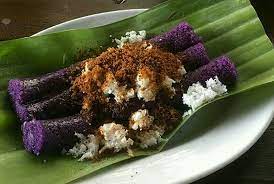December has started and that means that we are in the holiday season. The majority of the world is looking forward to Christmas. Time of the year which is traditionally spent with the family. During this time, in the Philippines, we have Simbang Gabi. Translated from the Filipino this means “Night Mass“. Basically, this is a series of masses that are being held early in the morning and it’s mostly being practiced by Filipino Catholics. You are probably wondering what this has to do with the food. Well, the main star of our recipe is a classic Puto Bumbong. A dish that is traditionally sold outside of the churches during Simbang Gabi.
In other words, the holiday season in the Philippines has started when you see food stalls outside of the churches. What cinnamon and turkey are in the USA during holidays, Bibingka and Puto Bumbong are in the Philippines. This rice cake needs a lot of care and some particular cooking tools to make it right, but I am here to help you. Read on and learn how to make a classic Puto Bumbong at home!
What Is Puto Bumbong Made Of?
If you are reading this recipe then you already tried this traditional Filipino dish and you know that this, in fact, is a dessert. With that being said, Classic Puto Bumbong is not meant to be the main course. Now let’s get down to business!
First and foremost, let’s see what ingredients we need.
Ingredients
- One and a half cups of black rice, rinsed and drained preferably
- One and a half cups of glutinous rice, also known as malagkit, or rice flour
- A teaspoon of food coloring, preferably purple (after all, classic Puto Bumbong is supposed to be purple)
- 3/4 cups of muscovado sugar, known as Barbados sugar. This is not easy to come by, but it makes all the difference in this dish
- One and a half cups of grated coconut
- Half a cup of soft butter
- Approximately one cup of water
NOTE: Instead of food coloring, you can use rice that is already colored purple. I prefer to use coloring.
Cooking Tools Needed for Puto Bumbong
At the start of the article, I wrote that certain cooking tools are needed to make Puto Bumbong. If you want to go into a full traditional mode, you will need something that is really hard to come by if you don’t live in the Philippines. But generally, these are the tools that you’ll need.
- Mixing bowl
- Cooking foil, aluminum one
- Grater
- Bamboo steamer (the most important piece of the puzzle, regular food steamer for everyday use can serve the purpose, but it just won’t be the same)
- Fresh banana leaves for serving, but this is highly optional and it’s mostly used for esthetic purposes. It doesn’t have anything to do with the taste of the cake. Good luck getting one of these!
How to Make Classic Puto Bumbong
We came to the most important part, and the most fun part, of course! It’s time to actually prepare Puto Bumbong. I’ll divide the preparation into five steps. That way it will be easier for you to follow them.
Step 1:
Add black rice, rice flour, and water into the mixing bowl. If you are not using the rice that is already colored, toss a food coloring in the bowl as well. Make sure that you add just enough water to cover the rice. Cover the bowl and leave it overnight so that the rice is soft enough.
Step 2:
Some people are using food processors for this step, but I prefer my hands. Once the rice soaks all the water and becomes soft enough, use your hands to create an even mixture. Break potential clumps to get a grainy mass.
Step 3:
Fill your steamer (preferably bamboo) with water. Water should cover half of the capacity. Turn on the heat and let it boil. In the meantime, prepare the foil. The whole point of using a foil is to simulate the actual bamboo tube, so just cut it into even pieces. Make sure that you have enough to wrap each Puto Bumbong in it. Place 3 big spoons of the mixture that you created in step one onto the foil and create long rolls.
Step 4:
Pick up the foil by its ends like you would do with the taco. Make sure that the shape of a roll doesn’t break and place it on the steamer. Simmer it for 10 to 15 minutes or until all the water from the steamer evaporates.
NOTE: Don’t press the rolls too hard and don’t wrap them in a foil. Steam won’t be able to pass through the rice in the way that it should if you do that.
Step 5:
Once done, move your classic Puto Bumbong from the foil onto the banana leaf, if you have it of course. If not, you can use a wooden surface similar to the pizza stone. Glaze the rolls with butter and spread coconut and sugar evenly.
Voilà! You are done. If you closely follow all the steps, the final product should look like the one below.

What is Puto Bumbong in English?
In the end, I’ll just describe what would this dessert be called in English, just in case you were wondering. Puto is a generalized term for steamed rice cake in the Philippines. Bumbong on the other hand means “bamboo tube”. This dish of big cultural significance to the Filipinos is traditionally prepared in tubes created from bamboo. However, that is hard to come by in the States or Europe, thus we used foil in my recipe.
So rough translation would be something like “rice cake steamed in the bamboo tube“. Of course, you are welcome to interpret it however you like.
I hope that you’ll give this recipe a try. It’s not easy to make properly and you’ll need some exotic ingredients, but it’s worth it. Trust me.
Let me know how your classic Puto Bumbong turned out. Cheers!



